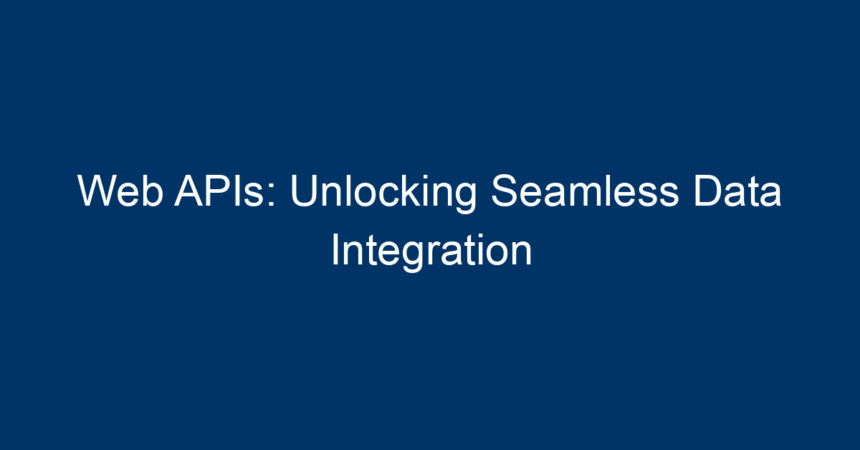In today’s hyper-connected digital landscape, organizations are constantly seeking innovative ways to streamline operations and enhance user experiences. One of the key enablers of this transformation is the Web API. Understanding and leveraging Web APIs can unlock seamless data integration, allowing businesses to connect disparate systems, improve functionality, and drive efficiencies that propel growth. In this article, we’ll explore the fundamentals of Web APIs, their types, benefits, practical applications, and best practices for implementation.
What are Web APIs?
At its core, a Web API (Application Programming Interface) is a set of rules and protocols that allows different software applications to communicate over the internet. By defining the methods and data formats that applications can use to request and exchange information, Web APIs bridge the gap between various services and systems.
- REST vs. SOAP: The most common types of Web APIs are REST (Representational State Transfer) and SOAP (Simple Object Access Protocol). REST APIs utilize standard HTTP methods and are known for their simplicity, while SOAP APIs are more protocol-heavy, ensuring security and comprehensive messaging.
The Importance of Web APIs in Modern Development
As organizations increasingly adopt digital solutions, the demand for smooth data integration becomes paramount. Here’s why Web APIs are essential:
1. Enhanced Connectivity
Web APIs enable seamless data exchange between different systems, software applications, and platforms. For instance, a business can integrate its customer relationship management (CRM) system with email marketing software, ensuring that user data flows effortlessly between the two.
2. Scalability and Flexibility
As businesses grow, their technology needs evolve. Web APIs allow organizations to scale their services efficiently. New features and services can be added without overhauling existing systems, making it easy to adapt to changing market dynamics.
3. Improved User Experience
With Web APIs, companies can enhance user interfaces and provide dynamic content. By pulling data from multiple sources in real-time, applications can present users with a more engaging and personalized experience.
4. Cost Efficiency
Developing applications that utilize Web APIs can be more cost-effective. Instead of building every feature from scratch, developers can leverage existing APIs to access the functionality they need. This approach saves time and resources while fostering innovation.
Key Components of Web APIs
To fully harness the power of Web APIs, one must understand their key components:
1. Endpoints
An endpoint is a URL where an API can be accessed. Each endpoint corresponds to a specific resource or function, such as fetching user data or updating records.
2. Request Methods
Web APIs utilize standard HTTP methods such as:
- GET: Retrieve data from a specified resource.
- POST: Submit data to create or update a resource.
- PUT: Update an existing resource.
- DELETE: Remove a resource.
3. Request and Response Formats
Most Web APIs use JSON (JavaScript Object Notation) or XML (eXtensible Markup Language) for data interchange. JSON is particularly popular due to its lightweight nature and ease of integration with JavaScript.
4. Authentication
Securing API access is crucial. Common authentication methods include:
- API keys: Unique keys assigned to individual users.
- OAuth: An open standard for access delegation, allowing third-party applications to access user data.
Use Cases of Web APIs
Web APIs have a wide range of applications across various industries:
1. E-commerce
E-commerce platforms often use Web APIs to integrate payment gateways, inventory management systems, and shipping services. This ensures a seamless shopping experience for customers and allows for real-time data updates.
2. Social Media
Social media APIs enable applications to integrate functionalities like posting updates, retrieving user information, and analyzing engagement metrics. Companies can leverage these APIs for marketing campaigns and customer engagement strategies.
3. IoT Devices
The Internet of Things (IoT) relies heavily on Web APIs for communication between devices and cloud services. This connectivity allows for data collection and real-time analytics, enhancing device functionality.
4. Financial Services
Financial institutions use Web APIs to facilitate transactions, access user authentication, and provide real-time market data. APIs also enable the development of fintech applications that enhance user engagement and financial literacy.
Best Practices for Implementing Web APIs
Implementing Web APIs requires a strategic approach to ensure security, functionality, and ease of use:
1. Keep Documentation Clear
Comprehensive and user-friendly documentation is vital for developers utilizing your API. Include detailed descriptions of endpoints, request methods, response formats, and examples to facilitate integration.
2. Use Versioning
As APIs evolve, maintaining backward compatibility is crucial. Implement versioning (e.g., v1, v2) to ensure that existing applications continue to function while new features can be introduced.
3. Secure Your API
Implement robust security measures, such as:
- HTTPS encryption to safeguard data in transit.
- OAuth for secure authorization.
- Rate limiting to prevent abuse and ensure equitable access.
4. Monitor Performance
Regularly monitor API performance, tracking key metrics such as response times and error rates. Utilize analytics tools to gain insights into usage patterns and identify areas for improvement.
5. Foster Community Engagement
Encourage developers to provide feedback and share use cases. Building a community around your API can lead to valuable insights, improvements, and greater adoption.
Conclusion: The Future of Web APIs
In a world where digital transformation is the norm, Web APIs are crucial for enabling seamless data integration. They offer organizations the flexibility to innovate, enhance user experiences, and connect systems in unprecedented ways. By understanding the fundamentals of Web APIs and following best practices for implementation, businesses can unlock a plethora of opportunities to grow and thrive.
Actionable Insights
- Evaluate Your Needs: Assess your organization’s current systems and identify areas where Web API integration could enhance functionality.
- Choose the Right API: Research existing APIs that can meet your needs instead of building from scratch. Consider factors such as documentation, security, and support.
- Get Started: Begin implementing Web APIs in a pilot project. Measure performance and user feedback to refine your approach before scaling up.
- Stay Informed: Keep abreast of the latest trends and technologies in the API space. Continuous learning will empower your organization to leverage new opportunities effectively.
By harnessing the power of Web APIs, you can position your organization for success in the digital era, ensuring that you remain agile, responsive, and capable of meeting your customers’ evolving needs.




